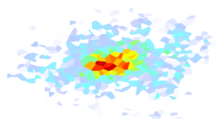Important
This ShakeMap 3.5 Manual is deprecated. Please see the ShakeMap 4 Manual.
3.1. Background¶
Until the development of ShakeMap, the most common information available immediately following a significant earthquake was typically its magnitude and epicenter. However, the damage pattern is not a simple function of these two parameters alone, and more-detailed information must be provided to properly assess the hazard. For example, for the 1971 M6.7 San Fernando, California earthquake, the northern San Fernando Valley was the region with the most damage, even though it was more than 15km from the epicenter. Likewise, areas strongly affected by the 1989 M6.9 Loma Prieta and 1994 M6.7 Northridge, California, earthquakes that were either distant from the epicentral region or out of the immediate media limelight were not fully appreciated until long after the initial reports of damage. The full extent of damage from the 1995 M6.9 Kobe, Japan, earthquake was not recognized by the central government in Tokyo until many hours later (e.g., Yamakawa, 1998), seriously delaying rescue and recovery efforts.
In contrast, a ShakeMap is a representation of actual ground shaking produced by an earthquake. The information it presents is different from the earthquake magnitude and epicenter that are released after an earthquake, because ShakeMap focuses on the ground shaking produced by the earthquake, rather than the parameters describing the earthquake starting point (its hypocenter) and size (magnitude). So, although an earthquake has one magnitude and one epicenter, it produces a range of ground shaking levels at sites throughout the region, depending on distance from the earthquake fault that ruptured, the rock and soil conditions at sites, and variations in the propagation of seismic waves from the earthquake due to complexities in the structure of the Earth’s crust.
Part of the strategy for generating rapid-response ground motion maps was to determine the best format for reliable presentation of the maps given the diverse audience, which includes scientists, businesses, emergency response agencies, media, and the general public. In an effort to simplify and maximize the flow of information to general users, we have developed a means of generating not only PGA and PGV maps, but also an instrumentally derived estimated Modified Mercalli Intensity (MMI) map. This “instrumental intensity” map makes it easier to relate the recorded ground motions to the expected felt area and damaging shaking distribution. At the same time, we preserve a full range of utilities of recorded ground-motion data by producing maps of response spectral acceleration, which are not particularly useful to the general public, yet which provide fundamental data for loss estimation and earthquake engineering assessments.
As mentioned, ShakeMap provides maps of peak ground-acceleration, velocity, and spectral acceleration as well as MMI. Intensity ShakeMaps depict estimated intensities derived from peak ground motions as well as (optionally) from reported intensities. Intensity maps make it easier to relate the recorded and estimated ground motions to the expected felt and damage distributions. Intensities are estimated from ground shaking using equations based on analyses of intensities reported near recorded seismic stations for past earthquakes, e.g., Wald et al. (1999b) or Worden et al. (2012). The legend on the ShakeMap indicates which relationship was used to estimate intensities from ground motions and vice versa (see the ShakeMap Technical Guide for more details).
Station locations are the best indicator of where the map is most accurate: near seismic stations, the shaking is well constrained by data; far from such stations, the shaking is estimated using standard seismological inferences and geospatial interpolation. Details about the interpolation; uncertainty maps; and codes for the seismic station components, network contributors, and potential outlier or clipped flag codes are provided in the Technical Guide. Peak horizontal acceleration and spectral acceleration values are in units of percent-g (or %g, where g = acceleration due to the force of gravity = 981cm/s/s). The peak values of the vertical components are not used in the construction of the maps. Peak velocity values are given (in cm/s) at each station. Acceleration spectra are the response of a 5% critically damped, single-degree-of-freedom oscillator to the recorded ground motion at three reference periods: 0.3, 1.0, and 3.0 sec.
